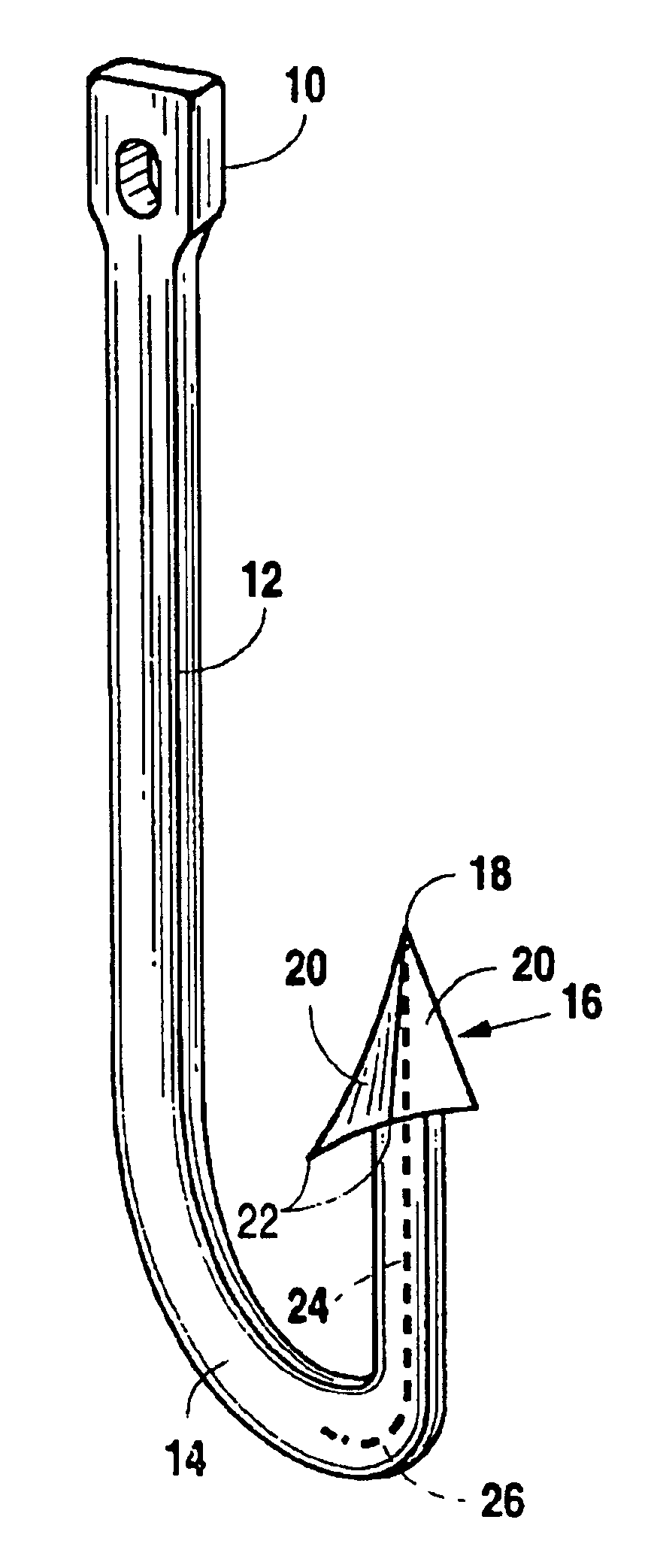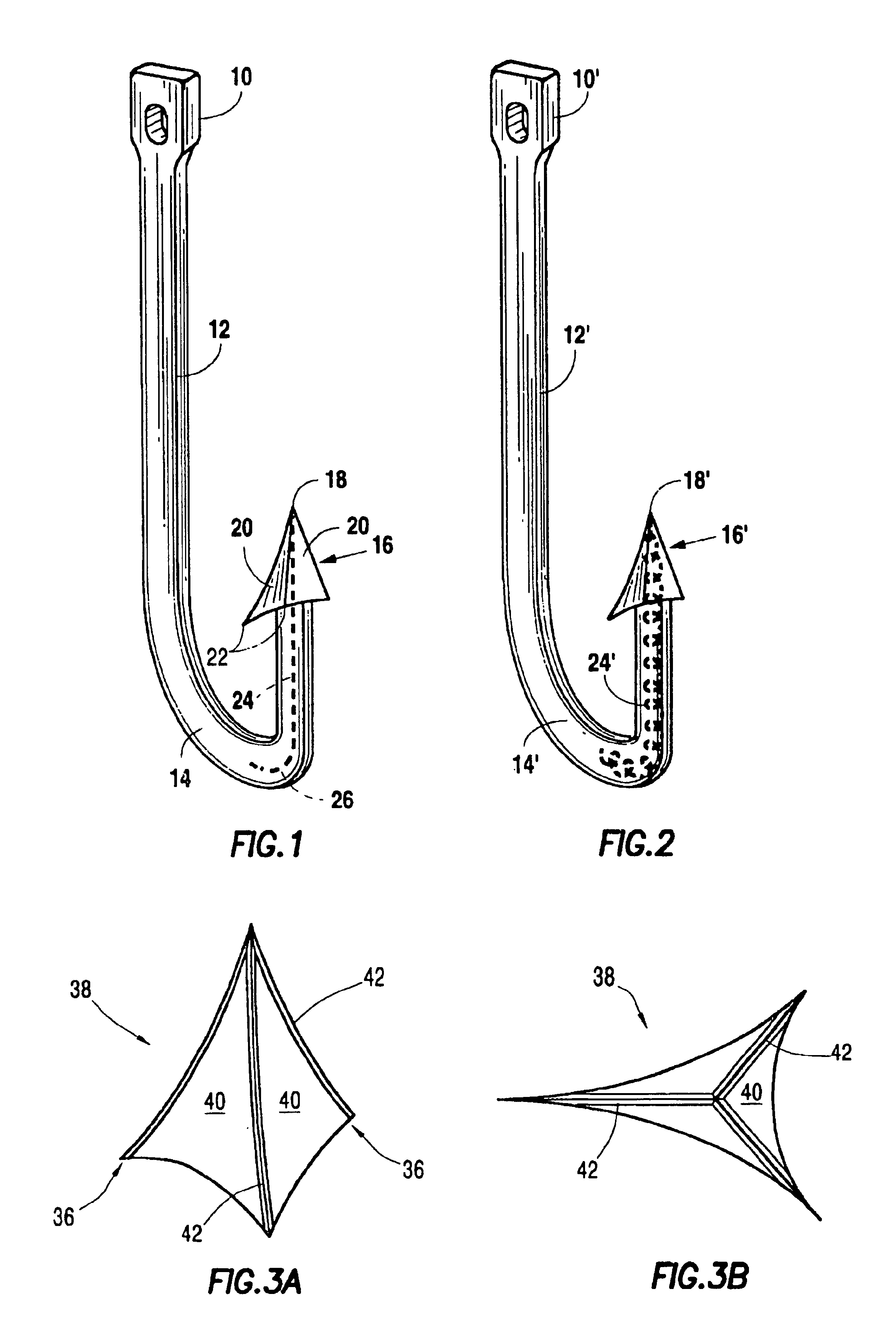Composite fish hook having improved strength and penetration capability
a technology of strength and penetration capability, applied in the field of composite fish hooks, can solve the problems of hampered acceptance by both commercial and sport fishing industries, inability to penetrate the mouth of fishes, etc., and achieve the effect of reducing friction
- Summary
- Abstract
- Description
- Claims
- Application Information
AI Technical Summary
Benefits of technology
Problems solved by technology
Method used
Image
Examples
first embodiment
[0018]Referring to FIG. 1, there is shown the fish hook of the present invention, which is comprised of an eye 10, shank 12, bight 14, and point 18, all molded of plastic to form a monolithic fish hook. Although those skilled in the art will recognize that, it is not a necessary component of the fish hook of the present invention, in the embodiment shown in FIG. 1, a barb 16 is formed at point 18 and two or more faces 20 taper downwardly and away from the point 18 in a generally pyramidal shape. The bottom corners 22 of barb 16 act to retain the fish on the hook after the barb has penetrated the mouth of the fish as known in the art. A longitudinal member, shown in shadow line at reference numeral 24, is substantially surrounded by, or contained within, the plastic comprising the hook and runs longitudinally through a portion of the length of the hook, extending out of the plastic forming the point 18, at one end.
[0019]Longitudinal member 24 is comprised of a material which is harde...
third embodiment
[0027]Referring now to FIGS. 3A and 3B, the present invention is shown which is in many respects identical to the embodiments shown in FIGS. 1 and 2 such that only the point 38 is shown. The hook shown in FIGS. 3A and 3B differs from the hooks shown in FIGS. 1 and 2 in the manner in which the point 38 is formed the manner in which the penetration ability of the hook is maximized. Specifically, molded into each of the shoulders between the faces 40 forming the point 38 are metal strips or blades 42 having the sharp edge of the blade extending along the shoulder so as to provide cutting edges which penetrate the fish's mouth. Again, the embodiment shown in FIGS. 3A and 3B includes a barb, indicated generally at reference numeral 36, but those skilled in the art will recognize that the hook need not include a barb. In a particular preferred embodiment, the blades 42 are fabricated from metal which is thin enough that the edge of the strip is itself capable of cutting, but the present i...
fifth embodiment
[0029]the fish hook of the present invention is indicated generally at reference numeral 48 in FIG. 5. Although hook 48 is shown as a treble hook, the component parts are again similar to the embodiments shown in FIGS. 1 and 2, and it will be recognized from this disclosure by those skilled in the art that any of the several embodiments shown and / or disclosed may be constructed as a treble hook. Further, treble hooks constructed in accordance with the teachings of the present invention may also include one or both of the flex characteristics and / or the connection part disclosed in U.S. Pat. No. 5,165,197, hereby incorporated into this specification in its entirety by this specific reference. In the embodiment shown in FIG. 5, the portion of the hook adjacent the point 58 is coated, or capped, with a layer 62 of material which is either a friction-modifying agent or a material having a hardness greater than that of the plastic comprising the hook. By use of the phrase “friction-modif...
PUM
 Login to View More
Login to View More Abstract
Description
Claims
Application Information
 Login to View More
Login to View More - R&D
- Intellectual Property
- Life Sciences
- Materials
- Tech Scout
- Unparalleled Data Quality
- Higher Quality Content
- 60% Fewer Hallucinations
Browse by: Latest US Patents, China's latest patents, Technical Efficacy Thesaurus, Application Domain, Technology Topic, Popular Technical Reports.
© 2025 PatSnap. All rights reserved.Legal|Privacy policy|Modern Slavery Act Transparency Statement|Sitemap|About US| Contact US: help@patsnap.com



